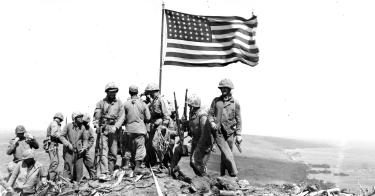My wife and I attended an extraordinary concert on Sunday, Feb. 23, by the brass ensemble of “The President’s Own” (the United States Marine Corps Band), commemorating the 75th anniversary of one of the toughest, bloodiest battles of the Pacific War—the Marine assault on Iwo Jima, which began on February 19, 1945.
The concert took place in the Leatherneck Gallery of the National Museum of the Marine Corps outside of the Quantico Marine Base in Triangle, Virginia, before a packed crowd, including a veteran of the Iwo Jima battle.
Iwo Jima (which translates as Sulfur Island) is a tiny, ugly island of volcanic ash, smoke, and tremors. Marine Corporal E. Hartman said the sand was “so soft it was like trying to run in loose coffee grounds.” The island is a little over four miles long and two miles wide, dominated by the 600-foot-high Mount Suribachi at its southern tip.
But Iwo Jima is only about 650 miles southeast of Tokyo. It had three airfields, along with radar installations that had been alerting Japanese interceptor squadrons and anti-aircraft batteries to American B-29 Superfortresses that were bombing the Japanese home islands from bases in the Mariana Islands.
Seizing the island from the Japanese would destroy Japan’s early-warning system; eliminate Japanese planes that were attacking American bombers; provide a safe base for B-29s low on fuel or otherwise damaged to land; and provide a staging area for P-51 fighters to provide escort protection for the American bombers hitting the Japanese mainland. Three hundred P-51 Mustangs that flew 1,700 sorties were eventually based there.
Prior to the invasion, a U.S. Navy task force hit the island with a massive bombardment. It was carried out for three days from February 16 to February 18 by six battleships, five cruisers, 10 destroyers, planes from 10 escort carriers (using newly invented napalm bombs), and even raids by land-based B-24s. Eventually, hundreds of Navy ships were supporting the Marines. Unfortunately, that bombardment had almost no effect on the 21,000-man Japanese garrison commanded by Gen. Tadamichi Kuribayashi, a former diplomat and haiku poet.
Iwo Jima was full of caves, deep ravines and rocky ridges that Kuribayashi had fortified with elaborate concrete and steel bunkers, some with as many as five levels, and connected through a labyrinth of tunnels. Many military historians conclude that no other battle area in modern warfare was as skillfully fortified by a combination of nature and human engineering as Iwo Jima. The Japanese safely sat out the bombardment with few casualties.
On Feb. 19, almost 30,000 warriors of the 4th and 5th Marine Divisions of the 5th Amphibious Corps (including Navaho code talkers), with the 3rd Marine Division in reserve, landed on the island with little opposition. Kuribayashi’s strategy was to allow the Marines to land, and then, within half an hour, subject them to massive mortar, artillery and machine gun fire—much of it directed by Japanese observers on Mount Suribachi, which had seven levels of underground fortifications.
By the end of the week, 70,000 Marines were on the island, advancing only yard-by-yard, under such a barrage of interlocking fire that Lt. Colonel Justus “Jumpin’ Joe” Chambers said, “You could’ve held up a cigarette and lit it on the stuff going by.”
It took tanks, flame-throwers, bazookas, mortars, and hand-to-hand fighting by the Marines to defeat Japanese troops who had pledged to die defending their turf. The fleet supporting the Marines with supplies and rolling artillery barrages on the island was also hit by Japanese Kamikaze attacks that sank one escort carrier, the Bismarck Sea, and damaged other ships, including the fleet carrier Saratoga.
Mount Surabachi was taken on Feb. 23, and the Marines planted a flag on the top of the mountain. A second, larger flag was then raised (which is currently displayed at the Museum). The raising of that flag on Surabachi is probably the most recognized and iconic battle photograph ever taken. It symbolizes the valor and dogged perseverance of the Marines in one of the toughest battles they ever fought. It was their bravery that was being commemorated at the Marine Band concert on the 75th anniversary of the raising of the flag. And the architectural design of the Marine Corps Museum evokes that photograph.
But the raising of the flag on the fifth day after the assault began was not the end of the story. The hardest fighting on Iwo Jima was still ahead as the Marines advanced towards the northern tip of the island. There were so many Marine casualties in the fight for Hill 382, one of the fortified Japanese positions, that it became known as “The Meat Grinder.” The Japanese made their last stand in a 700-yard-long canyon known as “Bloody Gorge” that took the Marines 10 days to clear out.
Military planners believed it would take two weeks to capture the island. Instead, it took more than five weeks—until March 26. Even on that day, 300 Japanese were killed after launching a banzai attack.
The Marines suffered their worst casualties of the Pacific War (and in their history) by the time the battle for the island was over, with almost 6,000 dead and over 17,000 casualties, with additional Navy sailors killed and wounded. Out of the 21,000-man Japanese garrison, only 200 Japanese surrendered. The rest fought to the death.
The taking of Iwo Jima by the Marines is credited with saving the lives of almost 30,000 American pilots who would otherwise have been forced to ditch at sea.
In fact, on March 4, the first crippled B-29 landed on one of the landing fields captured by the Marines while the battle for Iwo Jima was still raging. One pilot was quoted as saying that “whenever I land on this island, I thank God and the men who fought for it.”
There were more Congressional Medals of Honor awarded following the battle of Iwo Jima—27 (including to five Navy sailors)—than in any other battle in U.S. history. The ferocious bravery and determination of the Marines and sailors led Admiral Nimitz to say that on Iwo Jima, “Uncommon valor was a common virtue.”
Nimitz’s memorable words are engraved on the wall of the Marine Corps Museum. Our memories of that uncommon valor have not dimmed and will not dim as long as we continue to remember the gallant Marines who fought that fateful battle 75 years ago.
It is because of them and the sacrifices of so many other American soldiers (and their families) that we live in a free, bountiful country today.
This piece originally appeared in Fox News




